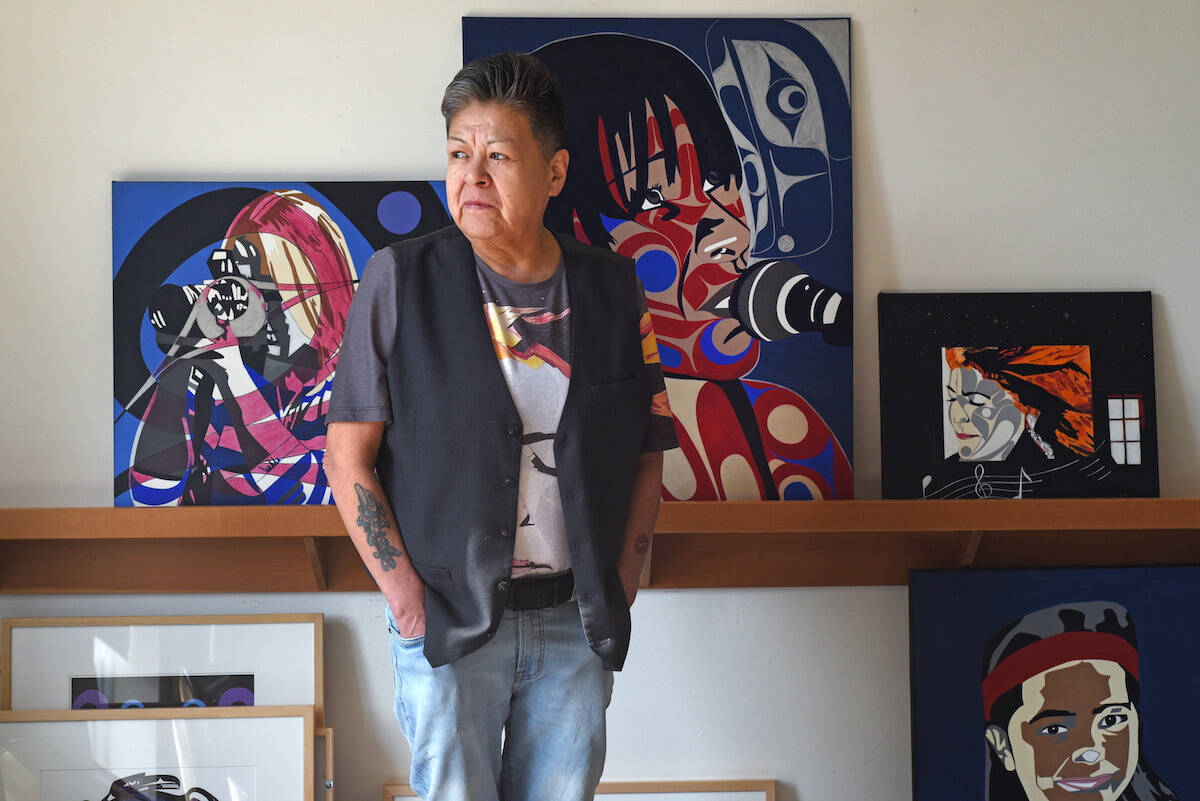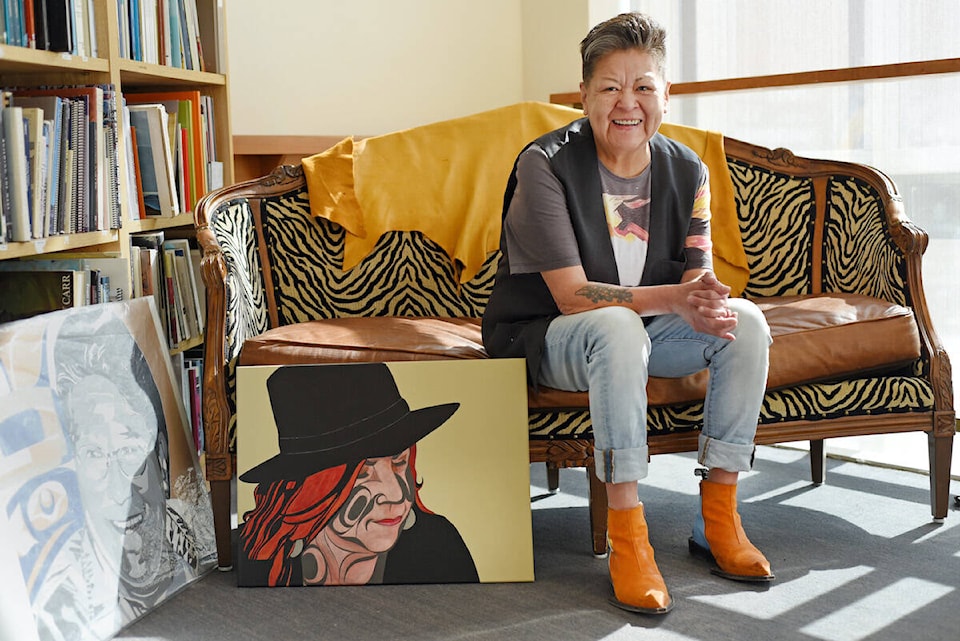Artist Francis Dick and Legacy Art Gallery curator Lorilee Wastasecoot are looking around at a room full of art that embodies the lifetime of Dick, when Wastasecoot pauses and calls attention to a specific piece.
“This is the print that we’ve named the exhibition after and it’s a powerful piece,” Wastasecoot said, referring to a print in reds, purples, blues and black titled Walking Thru My Fires.
“This is Francis.”
A wolf being resides in the middle of the painting, symbolic of Dick’s descendants of the Kawadelakala (Supernatural Wolf), who in legend shed his animal form to become the first of the Kingcome people. The wolf is surrounded by a circle of red flames, blue and purple faces, and sits on top of a tiny but significant white line in a circle of black.
“Often I cannot see the light that is around me because I feel such darkness so I created that little piece of light that I’m sitting upon that I can’t see, but I know it’s there,” Dick said.
“All those faces are about anger, different kinds of anger that we have … These are different forms of anger that I’ve experienced because of my history and having to embrace that and to honour that and to translate that into something beautiful.”
| Francis Dick, Walking Thru My Fires, 1992. |
This piece is just one example of symbolic art that tells a story from Dick’s life, conveyed through her powerful and dynamic art exhibit Walking Thru My Fires, running at the Legacy Art Gallery April 22 to Sept. 9. In this autobiographical showcase, the artist explores her life, identity and culture in a deeply personal way that both educates and explores topics such as the Indian Residential Schools legacies, urban Indigeneity, and reconciliation.
“I think it’s really safe just to talk about one’s experience rather than saying this is the experience of First Nations,” Dick said. “So I just tell my story through my paintings. Every painting has a story behind it that is relevant to my life journey.”
Dick is a prolific multi-media artist on the west coast, with her work having toured across North America, Asia and Europe. Her upcoming exhibit will fill the entire Legacy Art Gallery over five months in what Dick describes as “the best exhibition in my whole career as an artist.”
For the length of the exhibit, the gallery is making an interactive studio space under the mezzanine where Dick can paint, carve and design.
“People can come and talk and visit. They can engage,” said Wastasecoot.
| Dick's latest passion is designing and painting guitars for her upcoming exhibit at the Legacy Art Gallery. (Don Denton) |
Born in 1959 in Alert Bay, B.C., Dick is from the Musga’makw Dzawada’enuxw, or Four Tribes of Kingcome Inlet. Dick creates in the traditional Indigenous northwest coast formline style, but with her own twist - like using colours beyond the typical red and black. Her art reflects people, stories and memories of her life from both the community where she grew up and Victoria where she’s lived since 1985.
Memories like the time when she spent three summers teaching language, dance and song in the secluded village of Kingcome Inlet and started painting portraits of her students.
“All the houses are on stilts,” Dick recalls. “You have to take a canoe or a little boat up to the village, it’s pretty amazing.”
She pointed to a portrait of two young boys.
“Two of my most amazing students. This one was a bumblebee dancer,” she said, of a painting with abstract elements and a boy dancing with cedar bark regalia wrapped around him.
“He was dancing in one of the oldest big houses on the North Island. It is now destroyed and they’ve created a new Big House. I just thought it was so amazing, the symbolism of these young people performing in this really old place that they were going to start to tear down.”
She pointed to another portrait of a different student.
“This little girl used to call me Kwak’wala, which is our language. She was, oh my god, about five years old. So I’d be coming up the river from being back from Victoria, and as I’d be coming in down the river, she’d be running out yelling, ‘Kwak’wala! Kwak’wala! Welcome home!’ It was so beautiful to know I’ve impacted in a positive way,” Dick said.
And then there are the darker pieces, that tell just as much about a broader culture and world-experience as they do a personal one; paintings in honour of the suicide of her brother and the death of her grandmother - the two pieces that started her journey as an artist.
Attendees of the exhibit will also find the residential school desk project, featuring nine desks-turned-art pieces that have lights in them and are interactive with the music in the exhibit. These desks are a brave and tender proclamation of the severe sexual and emotional abuse that Dick experienced in the residential schools. Dick was taken to St. Michael’s Residential School at age five by her mother. When she left, a year and a half later, her mother had died and she was placed into the throes of foster care where she further experienced years of abuse. At first, Dick was going to use the desk project to honour specific people who had attended the residential schools, but soon realized that choosing was a difficult task.
“There’s so many that have gone through residential school and I thought I just really need to keep it to my story but I can honour others.”
Dick added: “I want to talk about truth and reconciliation with self first. Before anything else, it must happen here first, in my mind. And then within your family and then your community and then your nation and then the world, but you don’t just hop to: OK we’re going to have truth and reconciliation cause ‘that’s what I say.’ Bull***t. It starts from here.”
People will also be able to sit in the desks, bringing a more visceral understanding of what attending residential schools meant to those that endured the horror.
“I hope they come away with some truth, some rawness,” said Wastasecoot. “I really think there’s a lot of truth-telling that Francis does with her heart through every piece and every word she’s spoken and written about the pieces.”
The exhibit is co-curated with Wastasecoot, the gallery’s curator of Indigenous art & engagement, who curated the We Carry Our Ancestors (2019) and On Beaded Ground (2022) exhibits. Legacy Art Gallery is the University of Victoria’s art museum.
“I came across Francis Dick’s work - she has about 42 pieces in our collection, and I just thought: this is my first year as curator of Indigenous art & engagement. How do I want to work? And I really wanted to support contemporary Indigenous artists, and I would see Francis walking around Victoria, just chilling. Literally, she’s like our neighbour,” said Wastasecoot, referring to the fact that Dick’s studio is a few blocks away from Legacy. “And I thought: this is what I want to do with this collection.”
| Comes A Woman by Francis Dick |
Wastasecoot said it was the print called Comes a Woman, that Dick describes as “celebrating women”, that really struck her. “I just loved what she has to say about this one and the message that she conveys through that piece in her artist statement.
“Even though Francis and I are both, we’re Indigenous, but she’s Kwakwaka’wakw and I’m Cree, it just has that universality. It’s connection.”
Wastasecoot said that the exhibit is very female-centred, aiming to fill what she saw as a gap of Indigenous women in the gallery’s collection.
Visitors to Dick’s exhibition will see a wide body of work: the residential desk project, acrylics, seriographs, a coffee table, sand-blasted wood cuts, jewelry, and urban paintings, like one of the Johnson Street Bridge.
They’ll also get to see Dick’s newest passion: art that shows her love for music, including drums, six painted guitars and guitar straps, and portraits of local musicians.
“I love music … I think music could heal the world … That’s my newest love, raising up musicians in Victoria.”
Dick, who says she is now pretty much retired, is wearing Baggins Converse shoes (who she has done designs for) with her artwork print of local blues musician Deb Rhymer. She’s also painted Glenn Parfitt, well-known in the Victoria music scene.
What some may find surprising, is that after all this time, Dick still has difficulty thinking of herself as an artist.
“I never really thought of myself as an artist really. It takes a while, I think,” said Dick. “We never fully embrace who we are. It’s always a challenge, I think, or at least for me it has been, because of where I’ve come from and being a residential school survivor … coming from that world and growing up in this world is such a clash. You have to figure out how to survive in a world that is not really your world.
“That’s why I love doing the work that I do because I get to tell my story through my paintings and I can make my dark shadows into something beautiful,” she said.
No matter one’s background, there is something for everyone to take away from Dick’s body of work. Whether it is finding connection through deep personal human experiences - like loss, death, and estrangement - learning something new about another culture, celebrating human connection, or gaining deeper understanding into the pain of generational trauma from residential schools, one thing is certain, Dick’s work is both brave and poignant.
“I’m very honoured that you are willing to share so much with us as a team at Legacy, but also what you are going to be sharing with audiences,” Wastasecoot said.
See the work of Francis Dick at the Legacy Art Gallery, 630 Yates, from April 22 until Sept. 9.
Do you have a story tip? Email: editor@mondaymag.com.
Follow us on Twitter and Instagram, and like us on Facebook.

